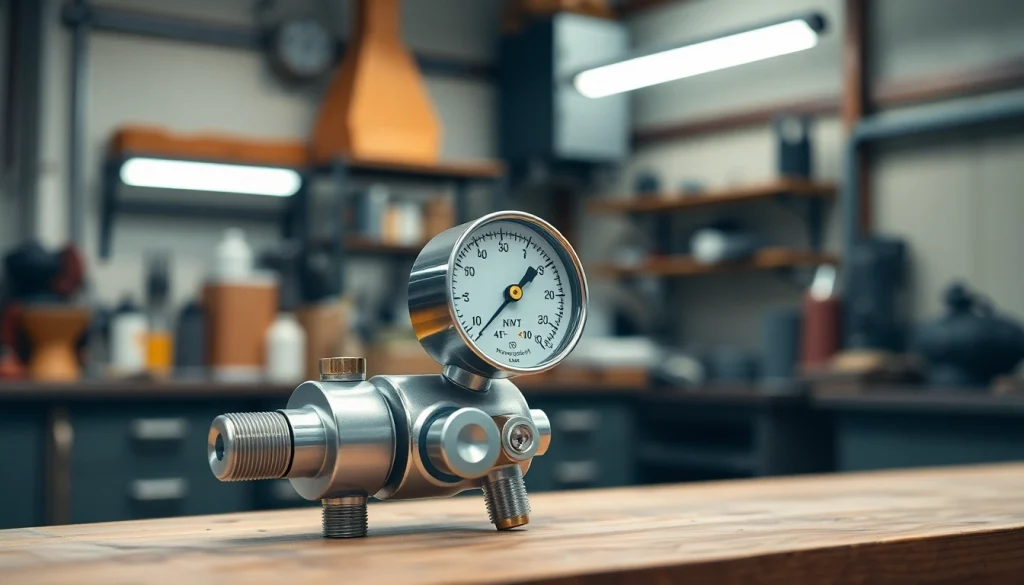Understanding Nitrogen Regulators
What is a Nitrogen Regulator?
A nitrogen regulator is an essential device used to control the flow of nitrogen gas from a pressurized cylinder to a designated application. These regulators play a crucial role in applications where precision is necessary, such as in welding, food and beverage preservation, and industrial processing. Essentially, a nitrogen regulator ensures that the gas is supplied at a consistent and usable pressure, preventing over-pressurization or fluctuations that could lead to unsafe operating conditions or decreased efficiency in processes.
How Does a Nitrogen Regulator Work?
The operation of a nitrogen regulator is based on the principles of pressure regulation. It consists of a few key components: an inlet connection, a pressure gauge, a control valve, and an outlet connection. When nitrogen gas is released from the high-pressure cylinder, the regulator reduces this pressure to a safer, more manageable level according to the needs of the application.
1. Inlet Connection: This connects to the nitrogen cylinder, allowing gas to flow into the regulator.
2. Pressure Gauge: This provides a visual representation of the gas pressure in the cylinder, enabling users to monitor pressure levels.
3. Control Valve: This is the heart of the regulator. It allows users to adjust the outlet pressure according to the requirements of the application.
4. Outlet Connection: After the gas has been regulated to the desired pressure, it exits through this connection to the intended application.
Common Uses of Nitrogen Regulators
Nitrogen regulators find applications in various fields due to nitrogen’s unique properties as an inert gas. The following are some common uses:
- Welding and Metal Fabrication: They are used to supply nitrogen for purging and protecting metal surfaces during welding processes.
- Food and Beverage Industry: Nitrogen is utilized for flushing packaging to extend shelf life without compromising flavor or texture.
- Industrial Processes: Many manufacturing processes require an inert atmosphere, making nitrogen regulators vital for controlling the gas supply.
- HVAC Systems: Nitrogen is used in pressure testing and repairs, necessitating reliable regulators.
Types of Nitrogen Regulators
Single vs. Dual Outlet Nitrogen Regulators
Nitrogen regulators can be categorized based on their outlet configuration:
- Single Outlet Regulators: These are equipped with one outlet port, suitable for applications requiring gas supply to a single device. They are typically sufficient for less complex configurations.
- Dual Outlet Regulators: As the name suggests, these regulators have two outlet ports, allowing simultaneous connections to two different devices or applications. This is particularly useful in industrial environments where multiple processes need nitrogen flow at once.
Adjustable vs. Preset Nitrogen Regulators
Another way to classify nitrogen regulators is based on how they control the outlet pressure:
- Adjustable Regulators: Users can manually set the output pressure according to specific application requirements. This versatility makes them ideal for applications with varying gas consumption rates.
- Preset Regulators: These regulators come with a factory-set pressure output. They are easier to use since users do not have to adjust the settings, but they offer less flexibility for applications that may require varying pressure levels.
High Pressure vs. Low Pressure Nitrogen Regulators
Nitrogen regulators can also be classified based on pressure ratings:
- High Pressure Regulators: Designed to handle pressures above 1000 psi, they are commonly used in applications involving high-pressure nitrogen tanks.
- Low Pressure Regulators: Suitable for applications requiring lower pressures, typically below 100 psi, these regulators help ensure safe and effective operation in sensitive environments.
Features to Consider When Selecting a Nitrogen Regulator
Pressure Rating and Flow Rate
One of the primary considerations when selecting a nitrogen regulator is its pressure rating and flow rate. Users need to determine their application’s required pressure and flow characteristics:
- Pressure Rating: This refers to the maximum pressure the regulator can handle. It is essential to select a regulator capable of meeting or exceeding the operational pressure requirements of the application.
- Flow Rate: This is the volume of gas that can pass through the regulator per unit time, typically measured in cubic feet per minute (CFM). A regulator with a higher flow rate is necessary for applications requiring a rapid supply of nitrogen.
Material and Build Quality
The material used in the construction of nitrogen regulators plays a significant role in their performance and durability. Common materials include:
- Brass: Known for its durability and resistance to corrosion, brass is a popular choice for both residential and industrial applications.
- Stainless Steel: This material offers superior corrosion resistance, making it ideal for harsh environments, such as marine or chemical industries.
Safety Features and Certifications
Safety is paramount when dealing with compressed gases. It’s vital to choose nitrogen regulators that include safety features and comply with relevant standards. Key aspects to consider include:
- Pressure Relief Valves: These prevent over-pressurization by venting excess gas.
- Certifications: Look for regulators certified by recognized standards organizations, indicating quality and reliability.
Installation and Maintenance of Nitrogen Regulators
Step-by-Step Installation Guide
Proper installation of a nitrogen regulator is crucial for operational efficiency and safety. Here’s a step-by-step guide:
- Gather Tools and Materials: Ensure you have all tools required for installation, including wrenches, Teflon tape for sealing, and safety goggles.
- Ensure Compatibility: Check that the regulator matches the nitrogen cylinder’s specifications, especially the inlet connection type (e.g., CGA580).
- Secure the Regulator: Attach the regulator to the nitrogen cylinder securely, using Teflon tape to prevent gas leaks.
- Connect the Outlet: Attach the outlet line to the intended application, ensuring a tight seal.
- Check Pressure Settings: Adjust the regulator to the desired pressure and monitor for any leaks before operating the system.
Regular Maintenance Practices
To ensure longevity and reliability, regular maintenance of nitrogen regulators is recommended. Key practices include:
- Leak Checks: Perform regular inspections for gas leaks, particularly at connections and seals.
- Cleaning: Keep the exterior clean, and ensure that any gas lines are clear of debris or contaminants.
- Calibration: Periodically test and calibrate pressure settings to ensure accuracy and performance.
Common Troubleshooting Tips
Even with proper maintenance, issues can arise. Here are common problems and their solutions:
- Inconsistent Pressure: If the outlet pressure fluctuates, check the regulator for wear or damage. Consider replacing worn components.
- Gas Leaks: If you detect a leak, re-tighten all connections and replace any worn fittings or seals.
- Blocked Flow: For obstructions, disconnect and clear any debris caught in the lines or regulator.
Comparing Top Nitrogen Regulators on the Market
Review of Popular Brands
When selecting a nitrogen regulator, it’s beneficial to look at top brands known for their performance and reliability:
- Victor Technologies: Renowned for high-quality welding equipment, Victor offers a range of nitrogen regulators known for durability and precision.
- Airgas: A supplier of various industrial gases and equipment, Airgas provides regulators designed for various applications, ensuring reliability.
- Smith Equipment: Another reputable brand, Smith manufactures regulators that are easy to use and maintain, with various offerings tailored to specific needs.
Pricing and Value Analysis
The price of nitrogen regulators can vary significantly based on features, quality, and brand. It is essential to evaluate the cost against the features provided:
- Budget Regulators: Priced around $25-$50, these are suitable for light-duty applications but might lack advanced features.
- Mid-Range Regulators: Typically priced between $50-$150, they offer a good balance of quality and performance for commercial use.
- High-End Regulators: At prices ranging from $150 and above, these regulators feature professional-grade materials, advanced safety features, and are durable for heavy use.
Customer Reviews and Feedback
Customer experiences provide valuable insights into the performance of nitrogen regulators. Here are some key points gathered from user reviews:
- Reliability: Many users highlight the importance of regulator reliability, with favorable reports on how well certain brands perform under demanding conditions.
- Ease of Use: Regulators that are user-friendly, with intuitive controls and clear pressure gauges, consistently receive positive feedback.
- Support and Warranty: Brands that offer solid customer service and warranties often receive higher ratings, as users feel more confident in their purchases.



